The Phoenicians were paramount in the spread of wine throughout the Mediterranean region, which is why it is odd that there is strikingly little archaeological evidence of wine production in Phoenicia itself. But things are changing as excavations at Tell el-Burak in Lebanon have revealed the first ancient Phoenician wine press. The structure was apparently rather innovative in its design, emphasizing the importance the beverage had both for Phoenician society and Mediterranean trade.
A Well-Preserved Phoenician Wine Press
The Iron Age wine press dates to the 7th century BC and its discovery is shedding light on the wine production of the Phoenicians and their construction habits. Dr. Adriano Orsingher, of the Eberhard Karls University Tübingen, Germany and lead author in the current study published in Antiquity later today , told Ancient Origins that this find is “the earliest evidence of wine-making installations in ancient Phoenicia.”
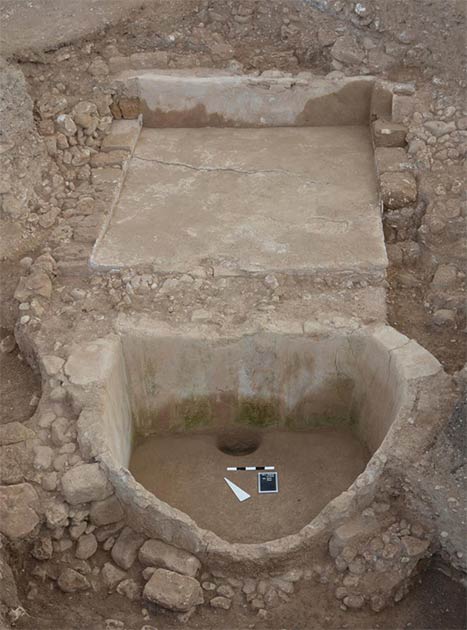
The ancient Phoenician wine press at Tell el-Burak from the south-west. (Courtesy of the Tell el-Burak Archaeological Project/ Antiquity)
The ancient Phoenicians were significant wine traders and key in the spread of the production and consumption of the alcoholic beverage across the Mediterranean, so researchers have been keen to find out more about Phoenician wine making.
This is why the discovery of the first Phoenician wine press in Lebanon is such a great find – by studying this well-preserved structure a team of researchers from the Eberhard Karls University Tübingen hope to glean more insight into the ways the Phoenician wine pioneers made the beverage.
The wine press’s discovery site, Tell el-Burak, is a small Phoenician site that was occupied from the 8th to 4th century BC. It is located near the modern city of Sidon, which was also an important Phoenician city. Sidon was on the maritime trade routes of the eastern Mediterranean and the current and previous discoveries at Tell el-Burak suggest that it was focused on supplying the wine that people in the area would consume and inhabitants in Sidon would trade.
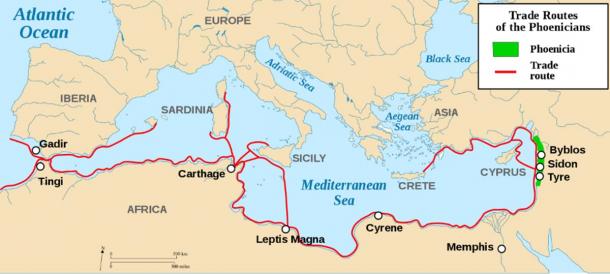
Phoenician territory and their extensive trade networks and settlements around the Mediterranean. (Credit: Rodrigo & Reedside / CC BY-SA 3.0 )
The Importance of Wine to the Phoenicians
‘Phoenicians’ is an ancient Greek term which is now used to refer to Iron Age Semitic-speaking people who lived on the central coast of the Levant from around 1200-332 BC. They used their trade routes to spread not only wine, but also their alphabet, which was adopted and adapted by the ancient Greeks and Romans.
Wine was a valuable commodity for the ancient Phoenicians, but it was also important for traditions and ceremonies in their society. Dr. Orsingher explained some of the ritual ways the ancient Phoenicians used wine:
“Wine consumption played a quintessential role in Phoenician feasting activities. Wine was also employed in libations, namely the act of intentionally pouring out liquids onto the ground, an altar, or another surface. In sacred areas, libations were poured to appease and thank deities and gain their favour, but they were also performed to honour or in memory of the deceased and ancestors in burial grounds.”
An Innovative Design
Wine obviously played a significant socio-economic role in Phoenician societies. The researchers believe that this is reflected in “the development of innovative solutions in the building technology of installations for the wine production.” This innovation can be seen in the design of the newly discovered Phoenician wine press .
It was built with plaster that was made by mixing lime and recycled ceramics, making the press stronger and easier to build. This is in contrast to the Bronze and Iron Age wine presses of the Levant (c. third to first millennia BC), which were generally hewn into the bedrock or built with stone blocks, according to the new paper. Dr. Orsingher told Ancient Origins that the design of the wine press really was unique:
“The archaeometric research offers the first evidence of a local and innovative tradition of plaster production in the southern Phoenicia, which is characterised by the mixing of crushed ceramic sherds with lime. Although the Phoenicians are often reported to have promoted the use of this type of plaster, the three installations of Tell el-Burak, dating from at least the 7th century BC, currently represent the first evidence of such a practice in the Phoenician homeland.”
The scientific analysis carried out at the Competence Center Archaeometry – Baden-Wuerttemberg (CCA-BW) of the University of Tübingen revealed that use of recycled ceramics mixed with mortar (a technique known as cocciopesto) would have made the construction of the Phoenician wine press easier, more water-resistant, and more durable. Later on, Romans improved upon this technique and used it in their buildings as well.
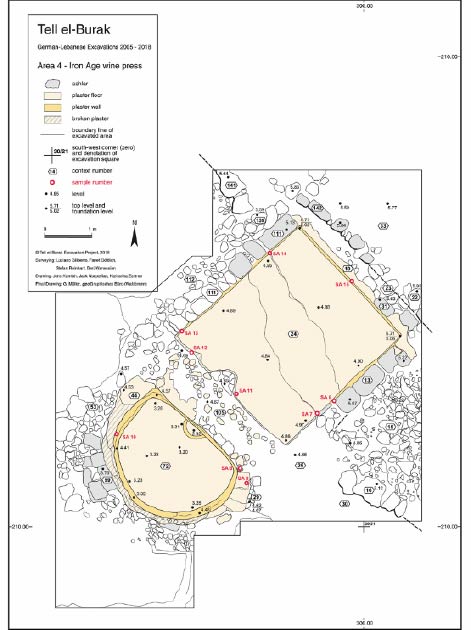
Plan of the ancient Phoenician wine press at Tell el-Burak, showing the position of the plaster samples. ( Antiquity)
The Structure of Ancient Wine Presses
In their paper, the researchers write that even though this is the first example of a Phoenician wine press, there are numerous examples of ancient wine presses in the “Levant and across the Mediterranean from the fifth millennium BC (or even earlier) to the first centuries AD” with which it can be compared. Although they vary in “building techniques, shapes, size and number of components” there are three important elements to ancient wine presses: a treading floor/basin where grapes were smushed, a connecting channel for must to flow through, and a sunken vat to collect the must and sometimes the first fermentation of the wine.
In the case of the newly discovered Phoenician wine press, the excavators have found a large rectangular treading basin that is attached to a large vat that they state “could hold roughly 4,500 liters of liquid, suggesting they were making wine on a large scale which was then shipped out in the large numbers of transport amphorae previously found.”
Two Mystery Installations
The researchers wrote in their paper that excavations have been underway to the Tell el-Burak archaeological site since 2001. One of the excavated areas has revealed three plastered installations, two of unknown purpose, and the third being the wine press.
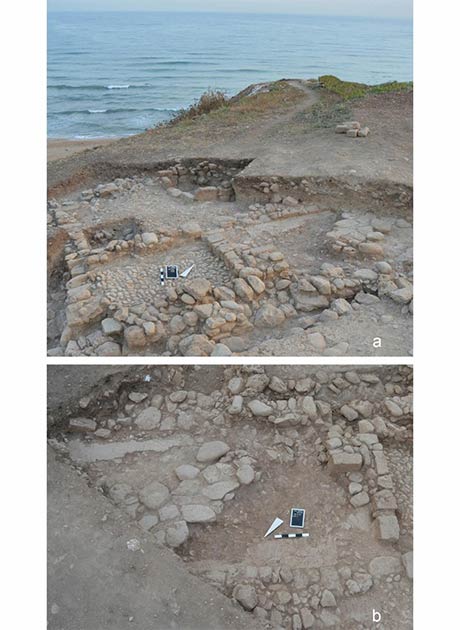
Structures at Tell el-Burak, area 3: a) plastered floor in room 1 of house 4, from the south-east; b) plastered floor in room 1 of house 4, from the north-west. (Courtesy of the Tell el-Burak Archaeological Project/ Antiquity)
One of those curious plastered installations is a basin-like feature that was unearthed beneath the floor of a courtyard. The other was discovered in a room, which was also coated with plaster, and had a plastered drainage channel in the wall between two rooms. The researchers are still uncertain of the relationship between those two plastered installations and the wine press. As they wrote in their paper:
“The exact chronological correlation of the three plastered installations, however, is yet to be established. Currently, it is thought —based on preliminary analysis of associated ceramics —that all three installations were probably constructed during the seventh century BC or, in the case of the wine press, during the late eighth century BC.”
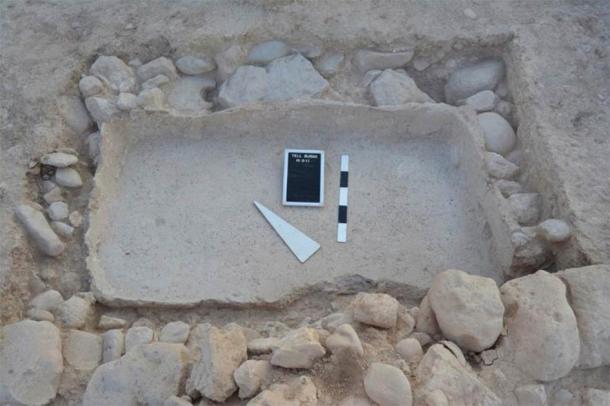
Plastered basin in room 3 of house 3 at Tell el-Burak, from the south-west. (Courtesy of the Tell el-Burak Archaeological Project/ Antiquity)
However, the wine press was the only installation that they believe was still in use after the beginning of the sixth century BC.
Dr. Orsingher told Ancient Origins that solution to the mystery of the other plaster installations may available in the near future. He said, “an organic residue analysis of plaster samples is currently ongoing at the University of Tübingen, which may determine whether all three plastered structures at Tell el-Burak were connected to wine production. At this regard, we also hope that the resumption of the excavations at Tell el-Burak in the Spring 2021 will provide us with more archaeological data.”
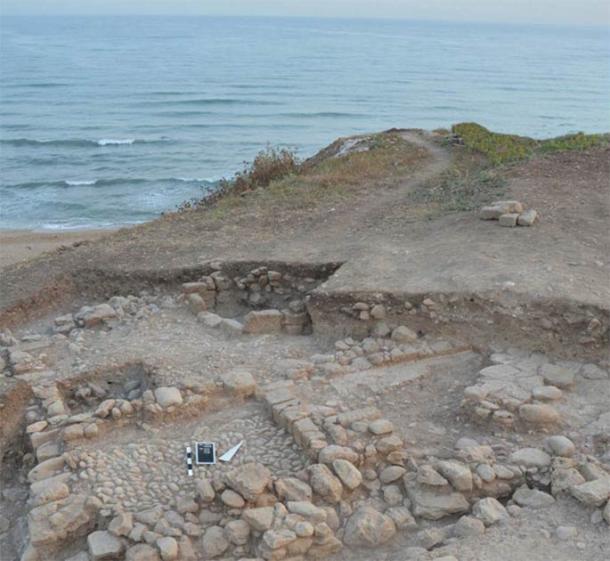
The remains of a house found at Tell el-Burak, Lebanon. (Credit: Tell el-Burak Archaeological Project/ Antiquity)
Dr. Orsingher also told Ancient Origins that the researchers will be conducting an “additional analysis to understand whether ceramic sherds were added into the lime plaster at Tell el-Burak to enhance its hydraulicity.” Furthermore, “putative evidence for a second press at the site was revealed by recent geophysical survey” so the researchers hope that “the continuation of the Tell el-Burak Archaeological Project’s fieldwork activities will likely provide new evidence to be considered in the study of plaster production at Tell el-Burak, and its role in the broader Iron Age Mediterranean context.”
The paper ‘Phoenician lime for Phoenician wine: Iron Age plaster from a wine press at Tell el-Burak, Lebanon’ is published in the journal Antiquity.
Top Image: Reconstruction of the wine press at Tell el-Burak, looking from the south-east. Source: Tell el-Burak Archaeological Project; drawing by O.Bruderer; Antiquity
Related posts:
Views: 0
 RSS Feed
RSS Feed

















 September 15th, 2020
September 15th, 2020  Awake Goy
Awake Goy  Posted in
Posted in  Tags:
Tags: 
















